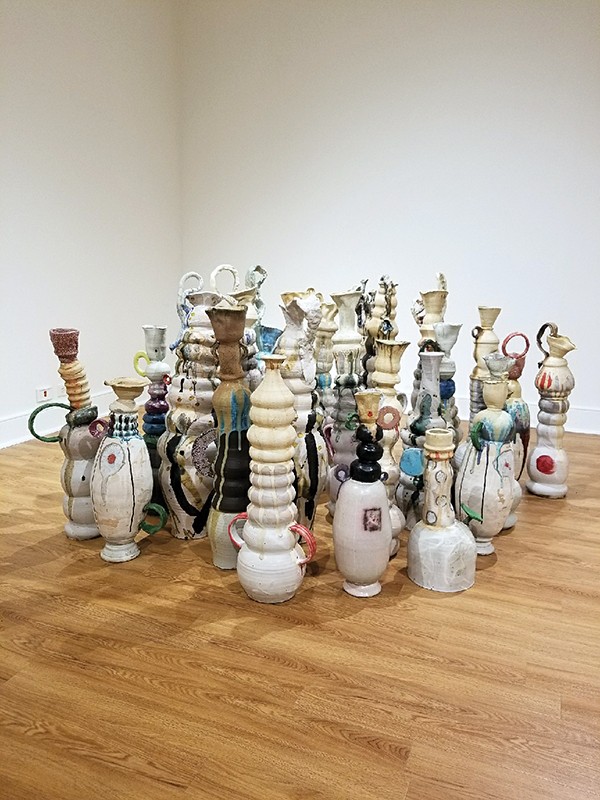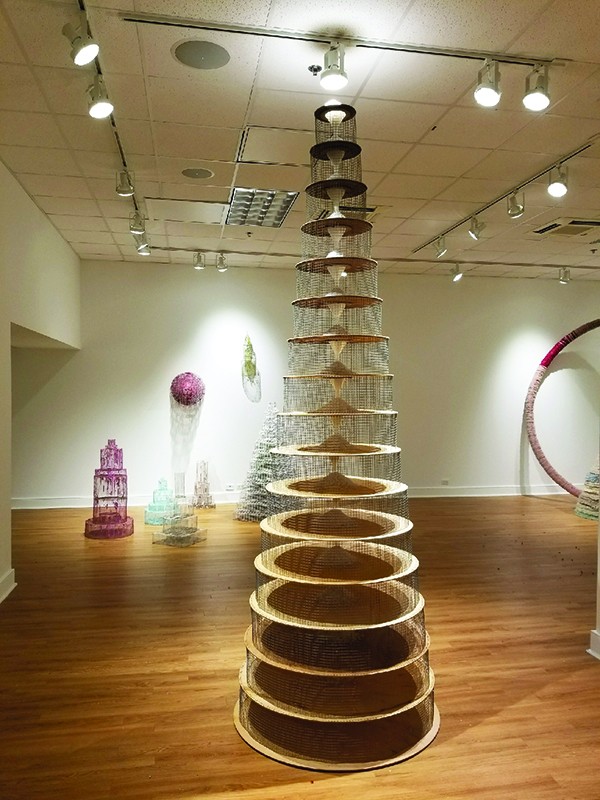Pillar of Salt: Don’t Look Back is the title of a work in “Niles Wallace: A Retrospective.”
“A little Biblical, but it would be real appropriate for a retrospective,” says Wallace, 70.
His last day as professor of ceramics at University of Memphis was August 31st, the same day his retrospective opened at the Martha and Robert Fogelman Galleries of Contemporary Art at U of M. The show, which runs through September 28th, features 22 works, which span Wallace’s more than 40-year teaching career.

Born in Oil City, Pennsylvania, Wallace remembered an elementary school teacher saying he “showed perspective” in his artwork. “Some kids have an understanding that things are in front of other things,” he says.
He took art in high school, but he “wasn’t in love with it. When I went to college I didn’t have any idea what to major in, but I thought, ‘Hey. I could be an art teacher.’ So, I was in art ed.”
Ceramics happened to be one of the classes he had to take. “That was something I immediately responded to,” Wallace says.
He made pottery on a potter’s wheel and “picked it up really quickly.”
In his junior year he realized, “Hey, I could actually have a career doing this.”
Wallace went to Alfred University in upstate New York to get his master’s degree. “Alfred really was the place to go at that time. It was like the major place to study ceramics in the Eastern half of the United States.”

Niles Wallace favors towers, as in Pillar of Salt: Don’t Look Back, part of “Niles Wallace: A Retrospective,” at the Fogelman Galleries.
Alfred “was a major turning point,” Wallace says. “I think going to Alfred really did transform my future.”
After he graduated, Wallace landed a job as the ceramics teacher at the State University of New York at Albany, but he lost his job when the school began cutting programs. He then got a job at U of M, which then was Memphis State University. “I didn’t think I would stay here. I figured two years max. It was just a completely different part of the country for me.”
All he knew before he got to Memphis was that it was hot. “I was here a month and I ended up getting into an argument with somebody about the Civil War: ‘What the hell is this about? Are we still fighting this?'”
He mostly did ceramics, but, he says, “I think one of the things I got from working in the art department here was an exposure to a lot of other influences. I was good friends with Larry Edwards and Steve Langdon, so I was exposed to painting a lot. And, certainly, when Greely Myatt came to teach at the university I became more involved toward sculptural ideas. By that time I was sort of doing sculptural ceramics. Not just making pottery. But all those influences mixed together and, at one point I think around the early ’90s, I essentially quit working with clay altogether and was doing painting and drawing and mixed-media sculpture and continued that until early 2000 and went back to ceramics,” Wallace says.
“Making objects that had significance was what I was trying to do. Probably still am to some extent. Some of the sculptures have to do with the idea of a vessel. A container. A space. Most of my sculptural pieces have some sense of volume to them.”
Around 2007, Wallace began making tower pieces after 9/11 in response to the World Trade Center attacks. Commenting on the attack was a popular theme among artists at the time, he says.
In the last couple of years, Wallace has been “embracing beauty again.
“I started with a real easy idea like flowers. Flowers are pretty and everybody loves flowers. Flowers represent life and death and rebirth and mourning. They’re central to art and have been for hundreds and hundreds of years.”
He began by making the flowers ugly. “I was painting with glaze on large platter-like bowls that would hang on the wall. So, they were like ceramic paintings. As soon as I started applying the glaze on them, sometimes the glaze would look more like an explosion or wounds more than they would look like flowers. Of course, ‘ugly’ is a really subjective term.”
In addition to his art show, Wallace is planning lots of yard sales at his Midtown home; he’s amassed a lot of his art over more than four decades.
Is the idea of retirement scary? “Sometimes I get a little panicky. I hope I figured this out right. I hope I’m not going to have to get a job at Walmart being a greeter. ‘Cause that would be a disaster because I’m not that nice.”